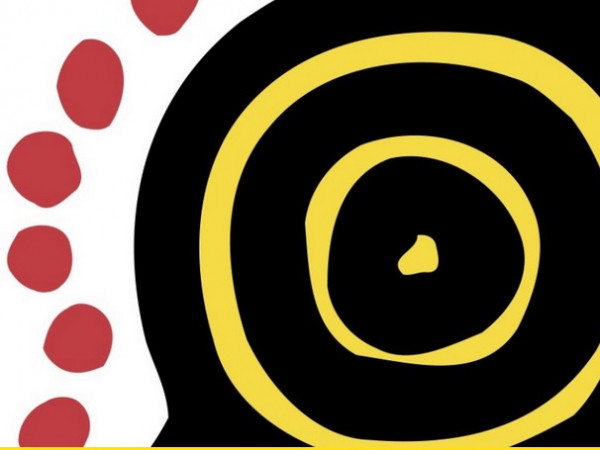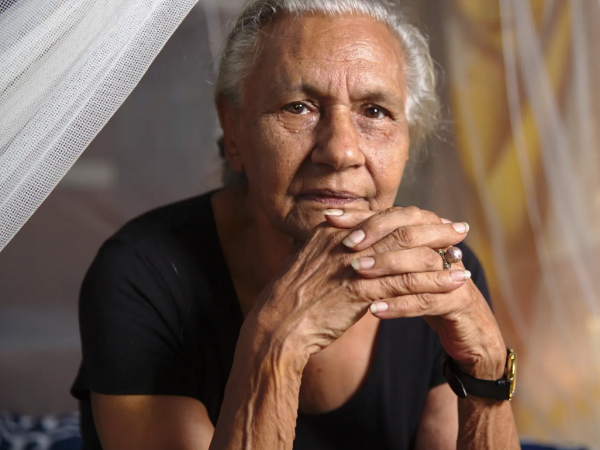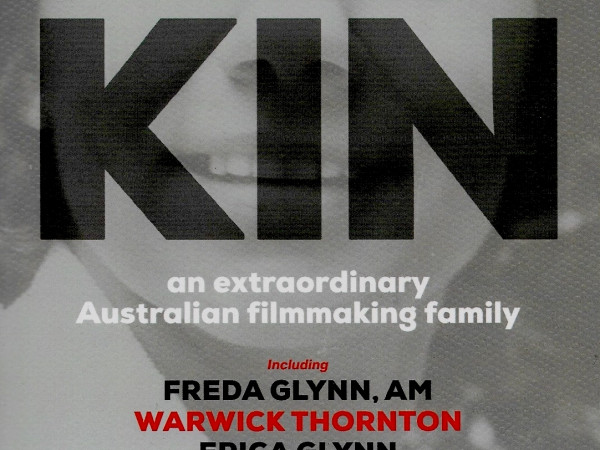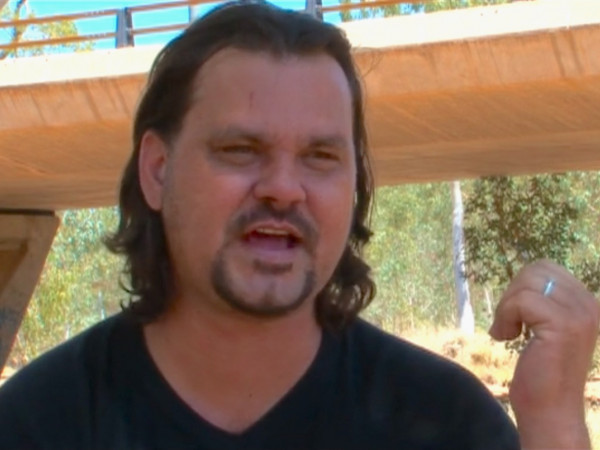Nicolas Lee
“It’s a difficult landscape at the moment…”
Well, that was the first major project I worked on. I think I may have edited a couple of Nganampa’s before we got stuck into that. I think it was being shot or like it started shooting a week or two after I arrived, which was in December 1990.
This is how I remember it, because it all happened so fast. I remember there were a few discussions about how it might go, but because of the timeline we had, which was really tight, I think we delivered the rough cut in ten or twelve days. I think it might have been ten days. And then we had a couple of days to tidy it up before we went into on-line.
I remember you two [Ivo Burum & Tony Dowmunt] sitting in a room and one of the Atco huts, um, on one side. And I was across the hallway on the other side of this hut, and…you sat in the room and kind of went through and did sort of pencil notes, um, on viewing the rushes. Um, I'd seen, I'd seen the rushes, but I was editing while you were making notes for the next sequence, almost at one point.
It wasn't a structural nightmare. Some documentaries can be.. this was very, um, you know, I don't mean to demean it all, but it was almost planned like a corporate video - like every … every interview was targeted. You knew exactly what you're going to ask them. Um, and I think the pithy, the pithy bits were obvious after the interview had finished, um, setting up those, you know, the counterpoint between Imparja and CAAMA - the different points of view and how they played out. Um, it was, uh, it was very clear to me. I was - to be honest, I don't know, I did have some structural questions here and there, which … we looked at. But, um, I pretty much was there to make it look good. Really, I think it was a producer's, it was a producer's doco. You know, it wasn't wasn't one that was made in the editing room, the story. It was it was all there.
It was almost - not quite edited in the camera - but… the structure was pretty, I think, predetermined. And yes, it could have been a more, uh, more observational and more ‘let's be led by what's happening around us’, kind of documentary, more time could have been spent with people, with more money, with more time…
But it's, in its construction, a lot of interviews and a sequence and a lot of interviews and a sequence, that that, that really, you know, told the story of the answers that we knew people you knew people, Ivo knew, were going to give - apart from one point. It was about eighty percent of the way through the film where, um, there was a spontaneous song and dance, uh, erupted or just happened before the cameras, um, the camera's lens. And, and, and that was followed and uh, that that's … that spoke volumes about the importance of those songs and the ceremonies for those people that there was that… someone remembered a song and everyone… you could feel the power in the singing and how much they were enjoying it. It was spine tingling. It would have been more so to be there. But even in the edit suite it was spine tingling.
Dion [Weston] the manager of Imparja at the time - if that’s his correct title - the managing director or whatever he was, um, uh, was unhappy with his interview. Um, he felt that the framing being downlow, making him looking dominating and the white, white guy… paternal… paternalistic kind of white guy with a bow tie. Um, he felt like he'd been set up.
I thought he made some very valid points, to be honest, you know - he was being quite frank about the fact that commercial television back then - and certainly I would say less so now, but certainly back then - I think it rang true that, um, uh, for him and let's face it, a lot of the Imparja commercial revenue comes from Queensland, not from the Northern Territory. And, um, I think he said ‘Aboriginal people on television don't rate’ - words very close to that, from memory. And, um, you know, a lot of people, a lot of commercial TV programmers still have that opinion. Um, you know, you've got Ernie Dingo, who gets on the Channel Nine if he's doing a travel show or something, but it's not cultural content….. And, uh, so that that that dilemma …that problem has always been there. And I think it's, um, it's playing out today, even in that, uh, you know, Nganampa is no longer shown on Imparja even … it’s not even made anymore because the money had to come through Imparja.
Nganampa never went out at eight o'clock on a Thursday night, you know, it went out on Sunday afternoon. Yeah. That for that very reason, um, which you know, the countrymen loved it, um and everyone wanted copies and yeah. Families are still coming off the street today and say, ‘Oh have you got that episode my grandfather was in…’ and …you know, knock out a copy for them and they go off, you know, happy and that's good.
So I stayed in Alice for about 7 years. So, um, the following year, uh, I edited a documentary called Benny and the Dreamers about the Pintupi coming in from out West, uh, which is a terrific film.
I do remember a lot of, uh, structuring in the editing room in that one. And we had longer - you know, I think I had a good six weeks to pull that one together story wise, um, and, you know, aesthetically and whatever. So that that was some of that was made in the editing room… you know, some of the structure was determined in the editing room. Uh, quite a lot of it. Yeah. But, um, interestingly enough…and then more Nganampa’s. I was editing… corporate videos, and kept doing that, um, for four years full time and then for another three years to-ing and fro-ing between Melbourne and …Alice. Mostly being in Alice. Yeah.
The main thing that CAAMA has achieved, apart from some of the programming that's gone out there… and the purpose that that's that's served… the training is just, it's just a remarkable history of training of, you know, some of the leading filmmakers in this country. I'm not saying Aboriginal leading filmmakers. I‘m saying leading filmmakers, the top award winners… have been indigenous in the last few years….not all of them, but a lot of them have. And a lot of those people came through CAAMA. You know, I think it was three years in a row, the Sydney Film Festival.. had an offspring, uh, offspring of, um, a descendant of Freda Glynn, uh, winning the best documentary at the Sydney Film Festival. That's just incredible. And one of them was her grandson. And he was the first of the three. … So it was it was Dylan, Warwick’s son. And then it was Warwick and then it was Erica. You know, Warwick’s sister – it’s … so wonderful. And Erica won with a documentary about her mother Freda Glynn.
The first graduate, notable graduate who left just before I arrived at CAAMA in 1990, I think halfway through, even months before I left - Rachel Perkins:, you know, award winning film, feature films, TV drama, documentaries, documentary series. Um, yeah. She set up Blackfella Films. That's that's a very, very… CAAMA’s, you know, in some way part of that story, in its foundations.
People often answer when you say what is CAAMA Productions, ‘Oh, it's the first you know, it was the first and the best…’ Well, it's no…it’s OK being the first and the best, you know, for a while. And then all these other ones sprung up, you know, and it's now no longer the only one. Uh, and there's a lot of competition out there making a lot of really interesting stuff… you know, East and West Coast, Top End, South Australia, across the country… and in Tasmania, of course, don't forget Tasmania…
That's been the majority of our work in recent years. Um, 15 minutes and half hour documentaries, mainly, when, you know, when trainees are around, you know: one year we did five fifteen minute documentaries. Another year we did three fifteen minutes and a half hour.
At that time there was three trainees in CAAMA um and that was a year and a half ago. And now there are none because times are tough…
…and I've said it, um, you know, at every meeting I've been to when these kinds of questions come up, um, that's, that's…when CAAMA started there were three million dollars training money, you know, for all departments: that's music radio, language department. I think there were twelve people in the language department when, you know, at the time Nganampa was running, uh, and when Satellite Dreaming was made, there were twelve people on the books…
There's no foundation programme anymore, like Nganampa was…. that trained people as well, at the same time as making stuff go to air that everyone loved, you know, on country, and in town. But yeah, it's a ….a difficult landscape at the moment.




